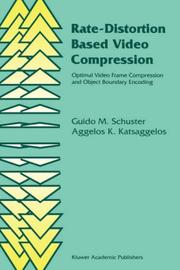| Listing 1 - 5 of 5 |
Sort by
|
Book
ISBN: 0387532927 3540532927 Year: 1991 Volume: 23 Publisher: Berlin ; New York : Springer-Verlag,
Abstract | Keywords | Export | Availability | Bookmark
 Loading...
Loading...Choose an application
- Reference Manager
- EndNote
- RefWorks (Direct export to RefWorks)
Image processing --- Image reconstruction --- Traitement d'images --- Reconstruction d'image --- Digital techniques --- Techniques numériques --- #KVIV:BB --- Techniques numériques

ISBN: 0792398505 1441951725 1475725663 Year: 1997 Publisher: Boston : Kluwer Academic Publishers,
Abstract | Keywords | Export | Availability | Bookmark
 Loading...
Loading...Choose an application
- Reference Manager
- EndNote
- RefWorks (Direct export to RefWorks)
One of the most intriguing problems in video processing is the removal of the redundancy or the compression of a video signal. There are a large number of applications which depend on video compression. Data compression represents the enabling technology behind the multimedia and digital television revolution. In motion compensated lossy video compression the original video sequence is first split into three new sources of information, segmentation, motion and residual error. These three information sources are then quantized, leading to a reduced rate for their representation but also to a distorted reconstructed video sequence. After the decomposition of the original source into segmentation, mo tion and residual error information is decided, the key remaining problem is the allocation of the available bits into these three sources of information. In this monograph a theory is developed which provides a solution to this fundamental bit allocation problem. It can be applied to all quad-tree-based motion com pensated video coders which use a first order differential pulse code modulation (DPCM) scheme for the encoding of the displacement vector field (DVF) and a block-based transform scheme for the encoding of the displaced frame differ ence (DFD). An optimal motion estimator which results in the smallest DFD energy for a given bit rate for the encoding of the DVF is also a result of this theory. Such a motion estimator is used to formulate a motion compensated interpolation scheme which incorporates a global smoothness constraint for the DVF.
Coding theory --- Video compression --- Codage --- Compression vidéo --- Coding theory. --- Video compression. --- Compression vidéo --- Optical data processing. --- Multimedia information systems. --- Signal processing. --- Image processing. --- Speech processing systems. --- Image Processing and Computer Vision. --- Multimedia Information Systems. --- Signal, Image and Speech Processing. --- Computational linguistics --- Electronic systems --- Information theory --- Modulation theory --- Oral communication --- Speech --- Telecommunication --- Singing voice synthesizers --- Pictorial data processing --- Picture processing --- Processing, Image --- Imaging systems --- Optical data processing --- Processing, Signal --- Information measurement --- Signal theory (Telecommunication) --- Computer-based multimedia information systems --- Multimedia computing --- Multimedia information systems --- Multimedia knowledge systems --- Information storage and retrieval systems --- Optical computing --- Visual data processing --- Bionics --- Electronic data processing --- Integrated optics --- Photonics --- Computers --- Optical equipment
Book
ISBN: 3031195027 3031195019 Year: 2022 Publisher: Cham, Switzerland : Springer,
Abstract | Keywords | Export | Availability | Bookmark
 Loading...
Loading...Choose an application
- Reference Manager
- EndNote
- RefWorks (Direct export to RefWorks)
Deep learning (Machine learning) --- Machine learning.. --- Learning, Machine --- Artificial intelligence --- Machine theory --- Learning, Deep (Machine learning) --- Iterative methods (Mathematics) --- Machine learning --- Machine Learning. --- Deep Learning. --- Artificial Intelligence. --- Therapeutic use. --- Aprenentatge automàtic --- Intel·ligència artificial --- Ús terapèutic --- Intel·ligència artificial.
Book
ISBN: 1108480721 9781108480727 Year: 2020 Publisher: Cambridge: Cambridge university press,
Abstract | Keywords | Export | Availability | Bookmark
 Loading...
Loading...Choose an application
- Reference Manager
- EndNote
- RefWorks (Direct export to RefWorks)
"The second edition of this text is a complete revision of our first endeavor, with virtually every chapter of the original rewritten from the ground up and eight new chapters of material added, doubling the size of the first edition. Topics from the first edition, from expositions on gradient descent to those on One-versus- All classification and Principal Component Analysis have been reworked and polished. A swath of new topics have been added throughout the text, from derivative-free optimization to weighted supervised learning, feature selection, nonlinear feature engineering, boosting-based cross-validation, and more"--
Book
ISBN: 9781108574020 1108574025 9781108575546 1108575544 9781108690935 1108690939 Year: 2020 Publisher: Cambridge, England : Cambridge University Press,
Abstract | Keywords | Export | Availability | Bookmark
 Loading...
Loading...Choose an application
- Reference Manager
- EndNote
- RefWorks (Direct export to RefWorks)
With its intuitive yet rigorous approach to machine learning, this text provides students with the fundamental knowledge and practical tools needed to conduct research and build data-driven products. The authors prioritize geometric intuition and algorithmic thinking, and include detail on all the essential mathematical prerequisites, to offer a fresh and accessible way to learn. Practical applications are emphasized, with examples from disciplines including computer vision, natural language processing, economics, neuroscience, recommender systems, physics, and biology. Over 300 color illustrations are included and have been meticulously designed to enable an intuitive grasp of technical concepts, and over 100 in-depth coding exercises (in Python) provide a real understanding of crucial machine learning algorithms. A suite of online resources including sample code, data sets, interactive lecture slides, and a solutions manual are provided online, making this an ideal text both for graduate courses on machine learning and for individual reference and self-study.
| Listing 1 - 5 of 5 |
Sort by
|

 Search
Search Feedback
Feedback About UniCat
About UniCat  Help
Help News
News